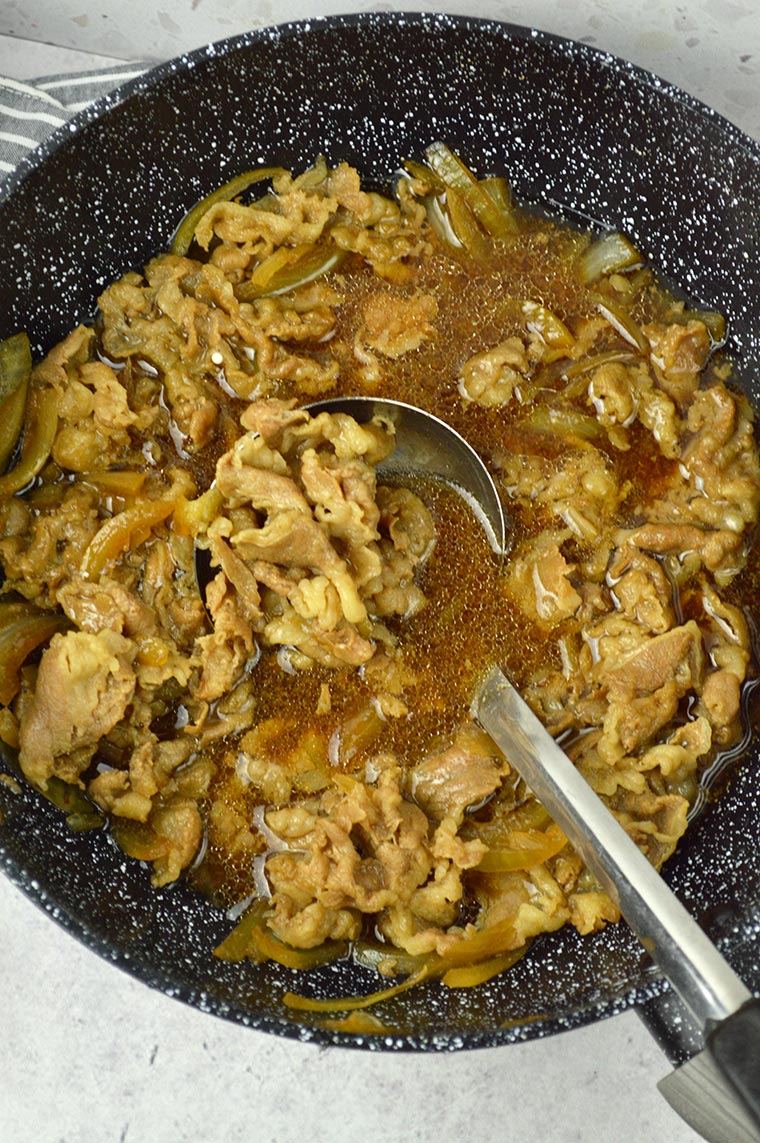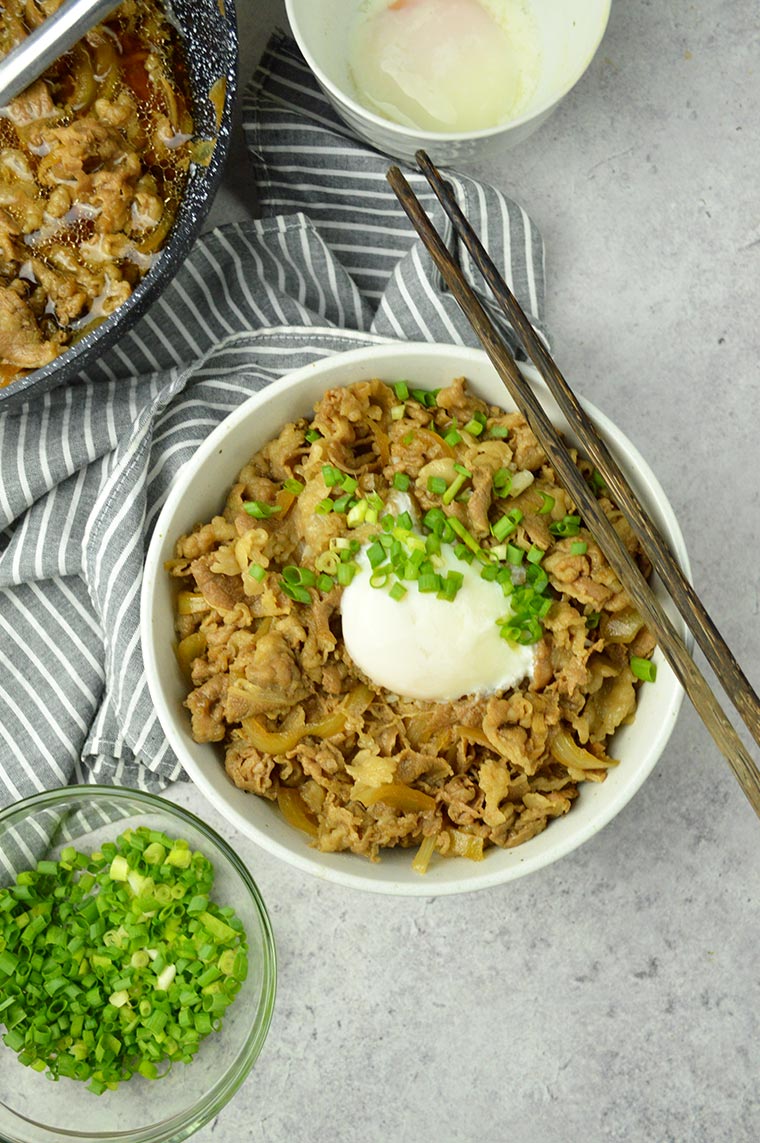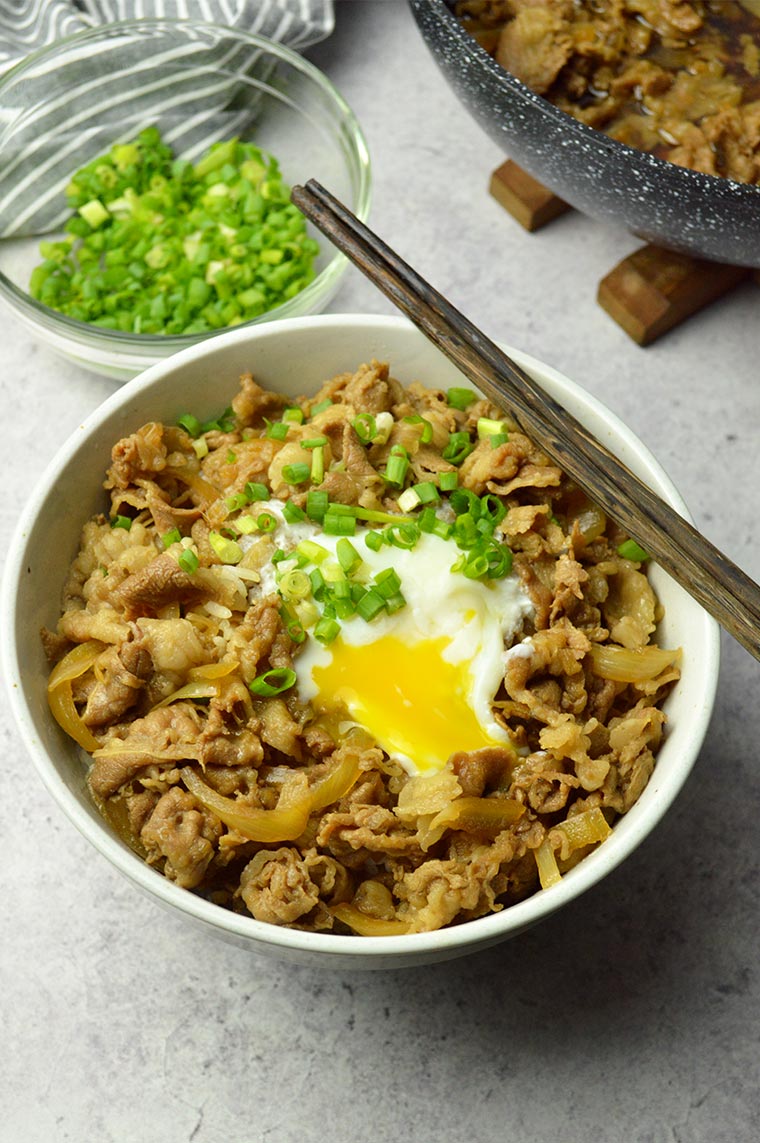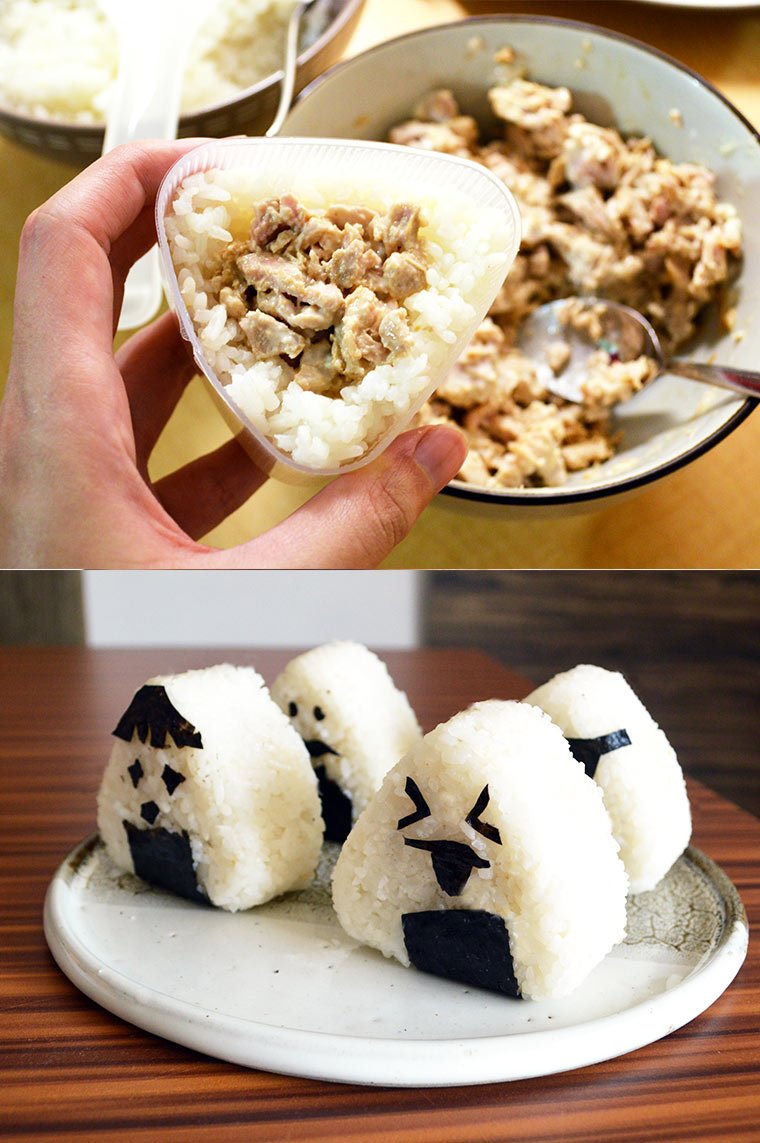Yoshinoya Beef Bowl (Gyudon)
This post may contain affiliate links. Please read my disclosure policy for details.
This incredibly delicious Yoshinoya Beef Bowl (Gyudon) is a recipe keeper, with juicy thinly sliced beef and tender sweet onion served over a bowl of steaming rice.

Make sure to save this Yoshinoya Beef Bowl recipe, everyone! I believe that once you make it, you will hardly go back to order this menu again at restaurants.
The secret to tender flavorful beef is to gently simmer the meat in a broth made from dashi, mirin, sake, and soy sauce. Sweet soy sauce flavored thinly sliced beef and onion are served on top of plain steamed rice. This incredibly delicious rice bowl recipe is unbelievably so easy to make and comes together in less than 30 minutes.
What Is Gyudon?
Gyudon is literally a beef bowl (“gyu” means beef, “don” is short of donburi or rice bowl). Gyudon is actually fast food in Japan. It is one of Japan’s best-loved convenience foods because it is cheap, filling, easy to prepare, and eat. People in Japan usually want gyudon for a quick lunch or dinner whereas western people go to McDonald’s or KFC. You can find those Gyudon fast-food chain restaurants everywhere in Japan.
Indonesian vs Japanese Yoshinoya Beef Bowl
Yoshinoya is a well-known Japanese fast-food chain restaurant in Indonesia. However, if you have ever compared the Yoshinoya beef bowl in Indonesia and Japanese, you will notice that they actually taste slightly different.
Why and how? Because the original beef bowl uses cooking wine or sake. Indonesia is a Muslim- majority population, so anything that contains alcohol is considered haram or prohibited.
I have actually posted a Gyudon recipe years ago. The difference is that the previous one was the dry version, made without dashi broth. In my opinion, it resembled the beef bowl from Indonesia’s Yoshinoya. Meanwhile, the current Yoshinoya Beef Bowl is made with dashi stock, is the copycat of the delicious authentic Japanese Yoshinoya rice bowl.
They are both delicious with their own charms. The one made without dashi has a stronger flavor because the seasonings are added directly to the beef. In contrast, the Japanese Yoshinoya Beef Bowl has more tender beef made from simmering the meat in a flavorful broth.
Every household makes beef bowl slightly different, so you can choose whichever style you prefer. If you are curious about them, try making both and let me know which one you like better on the comment below.

Yoshinoya Beef Bowl Ingredients
Now let’s look at what you need for this recipe:
- Thinly sliced beef. If you don’t eat beef, you can make this dish with thinly sliced pork as well. You can find thinly sliced beef or pork at local Japanese, Chinese, or Korean grocery stores or you can try asking the local butcher to cut it for you on a meat slicer. Make sure to use a cut of fatty meat because the fat keeps the meat moist, juicy, and tender. If you can’t find them in the refrigerated or frozen meat sections, you can purchase a block of meat and slice it when it is half frozen with a sharp knife on your own. Regardless of what cut of beef you use, it is crucial to slice the meat thinly against the grain. This is what makes it possible to cook the meat for such a short amount of time and yet still have it come out tender.
- Onion. The cooked tender onion will give sweetness to the dish. If you are not a fan of onion, you can skip it.
- Dashi. The beef and onion are simmered in the dashi-based sauce. If you don’t want to use dashi, check out my other Gyudon recipe.
- Seasonings. The beef and onions are cooked in a savory-sweet broth, made from the combination of dashi stock, mirin, sake, soy sauce, and sugar. The mirin has a sweet flavor, which makes a nice contrast when used with soy sauce. Sake is an optional ingredient, but it helps to remove the odor of meat, tenderize the meat, and adds umami and naturally sweet flavor to the broth.

How to Serve
Yoshinoya Beef Bowl is best served with a bowl of hot steamed rice. But you can also serve it over noodles, such as udon and shirataki noodles.
While purists tend to prefer their beef bowl unadorned, I like adding toppings to add extra flavor and texture. Here is a list of some condiments for beef bowl toppings.
- Scallions. Sprinkle some scallions on top to add a splash of color and a sharp fresh bite as the finishing touch.
- Sesame seeds. Toasted sesame seeds not only add a wonderful texture to the beef bowl but also give it a wonderful nutty flavor.
- Pickled red ginger (beni shoga). Pickled red ginger is made from thin strips of ginger pickled in plum vinegar. It gives a nice refreshing break to the palate, similar to how sliced pickles are added inside juicy burgers.
- Shichimi togarashi(Japanese seven spice). If you like your beef bowl slightly spicy, sprinkle some shichimi togarashi on top. It is a mixture of seven different kind of spices and adds layers of flavors.
- Onsen tamago. Onsen tamago or “hot spring egg”, is essentially a sous vide egg. It is a traditional Japanese low-temperature egg that is slow-cooked in the hot waters of onsen in Japan. The egg has a unique texture in that the white tastes like a delicate custard and the yolk comes out firm, but retains the color and creamy texture of an uncooked yolk.
- Aonori. Aonori is green seaweed that comes in flakes or powdered forms. It can be sprinkled on top of things to add umami-rich flavor to dishes.
- Egg mayo. This is one of my favorite toppings when I order at Yoshinoya in Indonesia. Egg mayo is simply made by mashing hard-boiled eggs and mixing them with Japanese mayonnaise which gives the eggs an extra tang and creaminess.
- Kimchi. Mostly known as Korean food, kimchi is a popular condiment in Japan as well. Japanese kimchi might not be as hot as most Korean kimchi, but it will add some spiciness, crisp texture, and refreshing tangy flavor to the beef bowl.
- Cheese. Who doesn’t love cheese? Some people enjoy cheese on just about everything, so why not also on the beef bowl.


More Easy Japanese Meal Recipes
While you are here, check out these easy and quick Japanese meal recipes below.

Ingredients
Toppings
- Onsen Tamago
- Scallions, finely chopped
Instructions
- Cut the thinly sliced beef into 3-inch/7.5cm long strips. Separate the beef so that it does not clump when cooked.
- Add dashi, sugar, sake, mirin, and soy sauce into a large frying pan. Stir until well combined. Put the frying pan over medium-high heat. Cover with a lid and bring the mixture to boil. (If you don’t cover, the sauce will evaporate)
- Add thinly sliced onion into the boiling sauce. Cover the frying pan with a lid and cook until the onion is tender for about 3-4 minutes.
- Once the onion is tender, add the beef. Stir and make sure the beef is submerged into the sauce. Cover the frying pan with a lid and cook for 4-5 minutes.
- Turn of the heat. Spoon the beef over rice.
- Serve with onsen tamago and scallions, or other toppings if desired.







So excited to finally find this copycat Yoshinoya beef bowl recipe! It tasted exactly like what I remembered. Good joob and thank you for the recipe.
JaJa you nailed it,this is a great recipe like I remember from my childhood. I was born and raised in and around Denver Colo. In the 70’s the Yashinoia restaurants were quite popular in Denver and we ate there often. 1 because it wes Delicious 2 it was fast (only one item on the menu the Beef Bowl) and drinks. At that Time the Beef Bowl and drink with tax was priced so that it cost the customers $3.00 even. No coins to worry about. In those days the yashinoia company purchased champion bulls to bread their cattle herds.if remember the story on the place mat was the all of the meat for the Beef Bowl was brisket. One time we parked in a parking lot across the alley behind the restaurant and when we left after our lunch I should note that I always loaded up on the pink pockled ginger so so so good. And you have duplicated it perfectly. I moved to Montana in 1980 and would find an Yashinoia on visits and the.one year the Yashinoia was gone so sad, so sad, so sad. None in Montana Shocking. It appears that the only place one can enjoy a Beef Bowl is in California. According to their website. Thank you for a great trip down memory lane. I do not understand why you have no reviews the recipe is awesome.